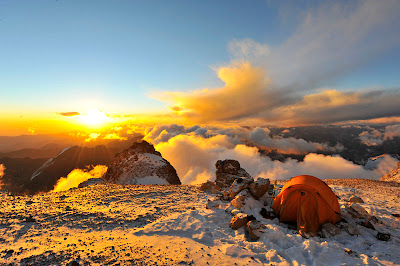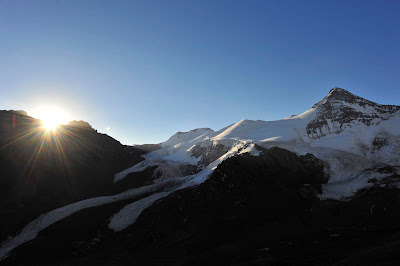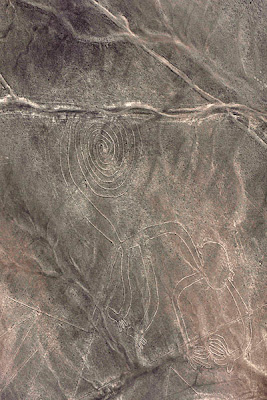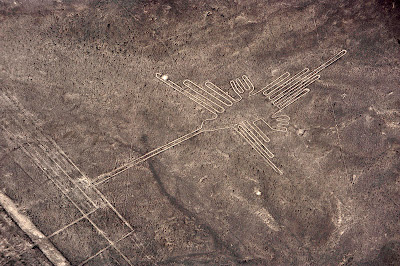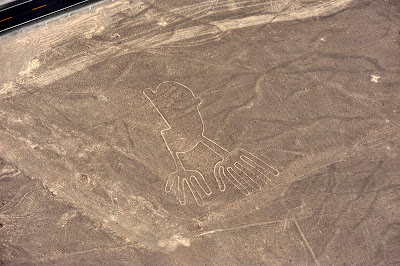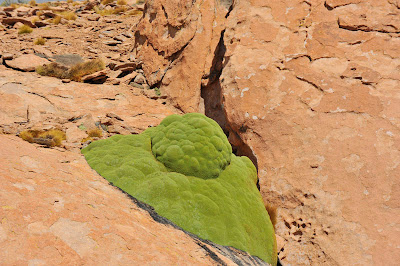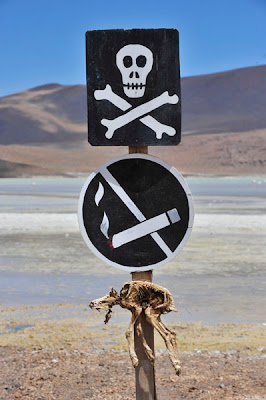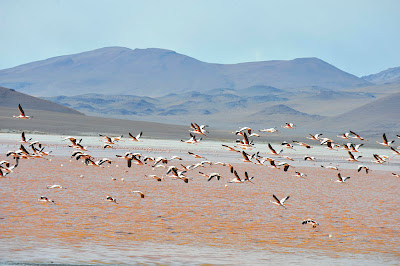The last few weeks has been all about epic long distance bus journeys. I had two deadlines i needed to make. Carnival in Bolivia (5th march) and Aconcagua mountain (6962m) in Argentina (by 15th March). So I couldn't hang about and will had to miss a lot of great sites on the way, including Machu Pichu!
Some borders are easier than other to cross and i read that entering Peru from Ecuador its highly likely you will get ripped off with dodgy taxi drivers. Coming from Quenca in Ecuador i had there was no direct bus to the border so i changed in a small city an hour north. Luckily a taxi was able to get me to a bus company that did direct border crossings to Tumbes in Peru, a town with departures further south. So no walking across no-man's land, and no need to take a taxi that may overcharge or even rob you. The worst thing i found on entering Peru was that all the bus companies have their own bus terminals, so you never know which one you need to go to get the right bus, or what time it will be. I wasn't really sure where to go so i asked some other people who were on my bus if they were going to Lima, the capital, and if i could join them. One was from Argentina, and luckily i thought, the other was from Lima itself. This town was serviced by rickshaws, not taxis, so the 3 of us with our backpacks barely managed to squeeze in. After that the arduous journey to Nazca (of the famous Lines) continued.
Without any information we could only rely on the driver to take us to the write place. I don't know if he was ripping us off or what, but he took us to a company which didnt have buses to Lima, so we had to go to another place. Of course, we had to pay double for the extra distance. And i thought travelling with locals would be easier! Even at this station there were no buses to Lima, but we were in no mood to try another one, so we took a bus another 10 hours down the desert highway. In the morning we had to take another taxi to a different station. There was a bus leaving for Lima in 30 minutes. We paid, put out luggage in and relaxed. After 40 minutes the conductor told us they didn't have enough passengers and started giving everyone their money back. Now what to do? We sat on the side of the highway for the next hour hoping something would come by. Eventually the conductor of the passenger-less bus called another company and told us there were seats available. One more taxi later and we were on a bus to Lima, with passengers! By 10pm we had arrived and i was wondering if i was capable of continuing the last 12 hours to Nazca. But after arriving and finding a bus at the same station, with passengers and seats available to take me without another taxi ride across the city, i jumped at the chance to keep going! The girl from Lima went home and the guy from Argentina was going to Chile (another 24 hours!). I made it to Nazca early morning and crashed at a very nice and cheap hotel in the middle of town. 45 hours and 7 taxi rides later! For the record, there is absolutely nothing to see on a bus journey through coastal Peru. After 45 hours, all i had seen was desert and about 5 minutes of coastal scenery. If you have the money, flying must be the way to go!
The scenic flights to see the Unesco listed Nazca Lines used to be very competitive and quite cheap, after a few fatal crashes however, the airlines and pilot have been regulated to a few planes which cost about $130 (its cheaper to buy directly at the airport) for a 15 minute flyby of the major lines. Air is the only way to clearly see the shapes and patterns created by removing sun-darkened stones from the desert surface to expose the lighter soil below. No-one knows why these patterns were made, but its one of those things that is mysterious and intriguing to see. Unfortunately, over the years, since they were discovered in 1939, thousands of tyre tracks of people going out to investigate, have ruined the landscape and made viewing the patterns very difficult. Even though its illegal to go out on your own now, it wont bring back the original scenery.
 |
| Nazca Lines |
 |
| makeshift houses in the desert |
The next night i'm supposed to be on a bus to Arequipa, another Unesco site, due to its historic cultural centre, but I'm there to climb El Misti a Mt Fuji look alike, but much higher at 5825m. Getting there is another problem though. After my long journey from Ecuador on buses which were not exactly the fanciest I've ever been on i decide to take the most expensive company with the best seats. Cruz del Sur has options of normal or first class seats. About 50% more expensive than other companies, but 100% worth it, i take the first class seat. An hour after the bus should have arrived though, a man comes up to me, and a Japanese guy I've been waiting with (we are the only two people waiting), saying that the bus has broken down and we need to get in his car and drive an hour to another bus which will take us the rest of the way. He asks if its OK, I only barely understand what he has said to me in Spanish, we don't even know who he is but its 11pm and we don't much much choice so we say ok. 2 hours speeding through the desert later, at 1am, we get to the other bus which takes us the rest of the way through the night. When we arrive I complain to the bus company and ask for a refund. It wasn't exactly the smooth, comfortable ride i had imagined. In the end, with help from the girl at tourist information, we both get about 50% off our next bus ticket. I only wish it could have been longer than the 6 hours to the Bolivian border.
I decide to stay with the Japanese guy who has been told of a Japanese friendly homestead in Arequipa. I'm the first non-Japanese to stay with them in their home. They used to own a hostel near Machu Pichu but said other tourists were too much trouble, and smelled a lot! Luckily for me they were still very friendly. They didn't speak English or Japanese and we both learned a lot of Spanish in the next two days. My main aim though was to climb El Misti (5825m), getting there would be quite difficult on my own, but climbing here with an organised group was incredibly cheap, only $60 for 2 days, including 4x4 transport and food. A taxi alone would have cost me $40 so i decided to go with the group and do it the easy way. 5 of us started, 2 of us finished. A Canadian girl disappeared after 30 minutes. I'm not exactly sure what happened to her, either she was extremely unfit, extremely un-acclimatised, or both. At base camp, 4600m we set up camp and watched a beautiful sunset, thankful that the misty conditions on El Misti were likely to clear up for the summit. At 12 am we got up and had a quick breakfast and headed up to the peak. After 30 minutes an Australian started throwing up and then gave up with no energy. By 4.30am a Dutch girl became too tired to go on, and got into a sleeping bag the guide had brought, and waited for sunrise. The only other survivor was a German guy who like me, was the only person to have climbed a real mountain before. We got to the top about an hour after sunrise at 8am, took a few summit photos then took a very quick descent down a very steep but soft snow field. From the base camp to the bottom was very very tiring, the total climb was 2500m up, and down again, quite a tough trip in less than 24 hours. Waking up the next day in Arequipa was the first time i was actually able to see the whole mountain, very similar to Mt Fuji in Japan, and very nice looking. It was funny to think i was at the top of it the day before.


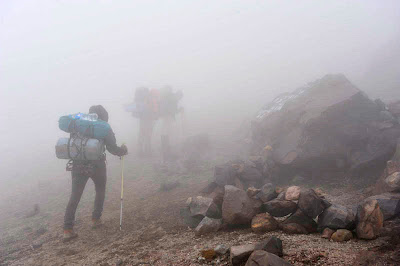


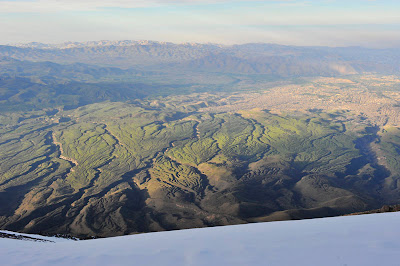
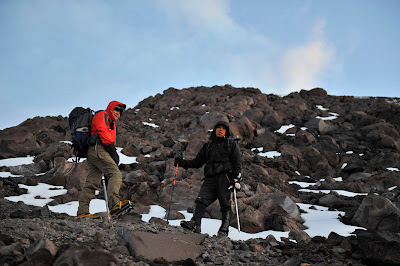



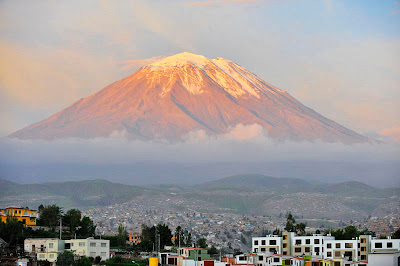 |
| El Misti 5825m |
I only had 3 days left to get to the Bolivian Carnival in time, so i made the hard decision to skip Machu Picchu. I had always intended to miss it, thanks to being there during the rainy season. But being this close (well 10 hours away is close in Peru), it was hard to get a bus in the direction of Bolivia, especially as the weather was perfect! I could at least be content knowing that the roads to Machu Pichu had flooded a few days ago making it impossible to reach, and that by going risked being stranded if it rained again and surely missing the Carnival.
I arrived in Puno near the Bolivian border at 14.28, my backpack was the first one off the coach and a man was shouting out the destination Copacabana, the place i wanted to go in Bolivia, on the edge of Lake Titicaca, one of the highest biggest lakes in the world at about 3820m. The bus was leaving at 2.30 pm and was the second and last bus of the day. Lucky my backpack was the first one off! Crossing the border was a breeze and there were about 20 other backpackers who all piled in to a beautiful lake side hotel, just in time to see the sunset. $8 for a very big en-suite lake view room with buffet breakfast. Perfect.
One night was all i had time for though, whether i could leave or not was another question. Until today there had been a strike by bus drivers on the road to La Paz (capital of Bolivia and highest capital in the world at 3660m).
No-one knew when the strike would finish, but when i woke up and went to investigate, there were plenty of buses looking for passengers to take to La Paz. By the time i was ready to leave, hoards of japanese, and other tourists had arrived on the previously blocked road. It was like the flood barriers had been opened, flooding the tranquil lakeside setting.
La Paz is a crazy looking city, The bus from Lake Titicaca goes through El Alto at 4000m and winds its way down the side of the steep valley to the city centre. The roads are really tight and packed with people, a lot of them women from the countryside but still wearing traditional clothing. Apparently they wear five layers of skirts, and no underwear. When they go to the toilet they just squat down and use the inside skirt instead of toilet paper, urghhhh!!!!
Carnival in Bolivia is the same celebration as Carnival in Rio or Venice, with lots of parades mixed with traditional elements. It changes every year between early Feb and mid March, the chances of it falling on any one day is quite slim, the chance of it falling on your birthday is once in a life time. This year, by coincidence it was on 5th March, my birthday, and a Saturday too, what a great day to have a birthday. To smarten up i had the second haircut of the trip. At $1.30 it was 30c more than the cut i had in El Salvador. For the same price he wanted to give me a shave too, a bit to extravagant for me, i said no. But still persistent he asked me if i drink beer - yes, sure…."well for the price of a beer you can have a shave too" what a salesman!
THE place to see Carnival in Bolivia is Oruro, a small town surround by silver mines, 4 hours south of La Paz. I had no idea what time the first bus would be, i was hoping it would be 5am, i got up even earlier and was lucky to find an earlier bus at 4am put on especially for the Carnival. I continued my disturbed sleep for the next few hours on the bus and arrived perfectly to see a pre Carnival parade called Anita Andina, a celebration for the coming harvest. Having nothing else of note to see for the rest of the year the hotels don't just double their prices for Carnival, they put them up 5-10 times the normal price. Even though the cheapest rooms woudn't break the bank at $50, its hard to feel good about paying so much over the normal prices. Luckily a guy from Couchsurfing from Oruro had arranged for a school to host more than 50 of us at only $7 a night. It was a bit sparten, with no beds or hot showers, but still it was nice to be in a big group for the Carnival weekend.
I'd read that carnival time can be very risky for people stealing money and cameras etc… Some people even rugby tackle you around the neck until you faint and then steal everything you have. I've managed to hold onto everything so far and didn't want to risk losing anything, especially on my birthday! Luckily Juan Carlos the couchsurfing organiser was an enthusiastic photographer who told me it was possible to get a press pass to access the parade, it only cost $30 which was about the same price as a seat on the parade route, but far more valuable to me, for taking photos and avoid losing my camera in the crowds!
I started shooting at 7am at the departure point and didn't stop until 4pm when my battery died after 2000 shots! I thought about recharging and going through the night, but being my birthday i decided to enjoy the second half of the day/and night. After 2 litters of cuba libra (rum and coke) I finally got back to the school at 10 am the next day! Great Carnival and great birthday! One downside of the celebrations is throwing of water, but more recently these days spraying of foam in pressurised cans. Its supposed to be fun, but some people use it to harass girls and foreign tourists or to blind people and then steel their camera. Out of 50 people in the group about 10 had this happen to them and have their cameras stolen. I only got sprayed twice the whole time i was there, luckily by children having fun, not by thieves. I even bought my own can and sprayed a few people myself :)

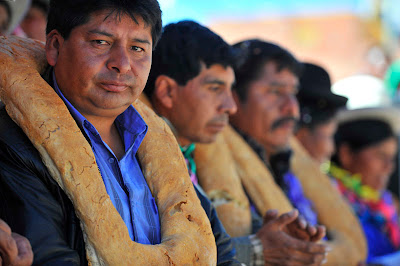
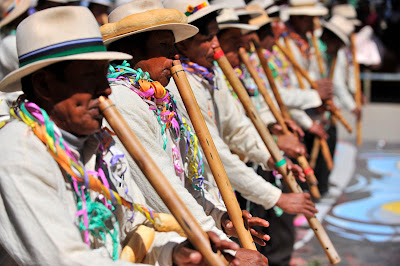
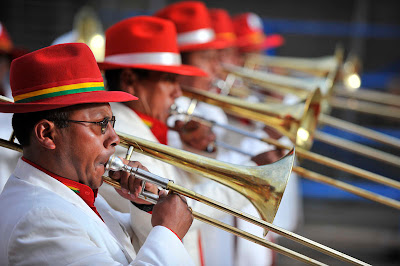

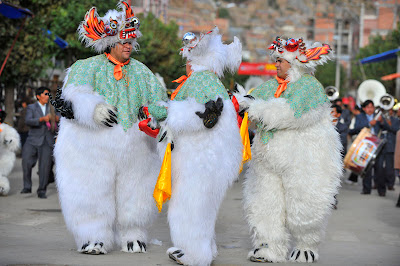



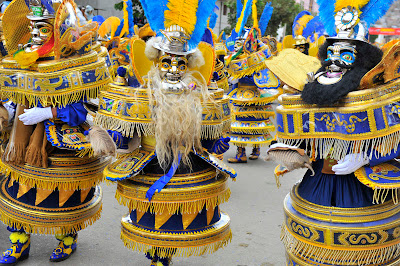

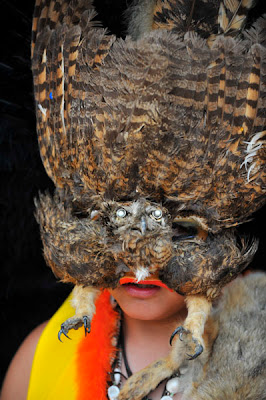
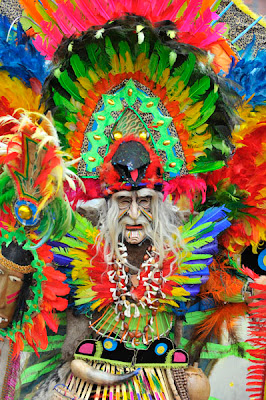
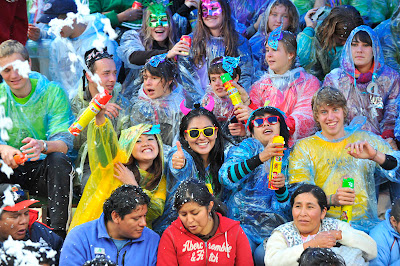

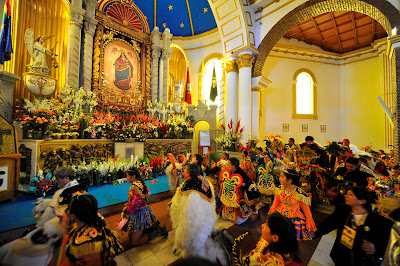

There's a lot to see in Bolivia other than Carnival, but the highlight and most popular trip is to Uyuni salt flats, in the dry season they are hard packed and blindingly white, for a few weeks a year (right now) they are under water and reflect like a mirror, and still blindingly white! the salt flats and surrounding area is almost inaccessible on your own, so I took a 3 day tour in a Toyota Land Cruiser with 2 people from Chile and 4 from japan. Perfect for practising my Japanese and improving my Spanish too! The tour itself wasn't very good, bad food, a driver/guide who didn't say a thing for 3 days, except Vamos (let's go) 5 minutes after every time we stopped to see something. The landscape at least made up for the poor tour.
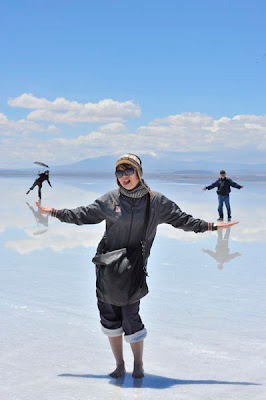 |
| Uyuni salt flats |
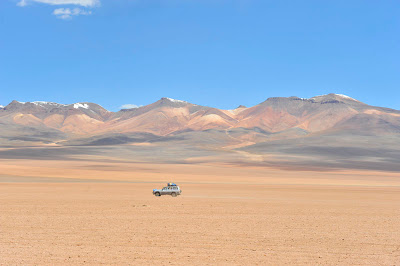 |
| driving at 4500m!! |
South of Uyuni is northern Argentina, my next destination, but another long journey was in the way of my getting to Mendoza, wine country and home to the highest mountain outside the himalayas, Aconcagua (6962m). 9 hours on the train 5 painfully slow hours crossing the border, 7 hours to Salta with a unscheduled stop over at midnight. And finally 18 hours by bus to Mendoza. Right now, I'm on the last bus, at least the final leg is giving me the chance to get up-to-date with this blog. The whole bus is like business class on a plane, with an attendant who brings meals and drinks around every few hours. The seats are leather (maybe fake leather), and very big and comfortable. I slept for 9 hours and did this whole blog entry. I'm in Mendoza now, it feels like Europe. Tomorrow I'll pick up my permit for Aconcagua. I'll be offline until the end of march when I'll let you know how the climb went!









